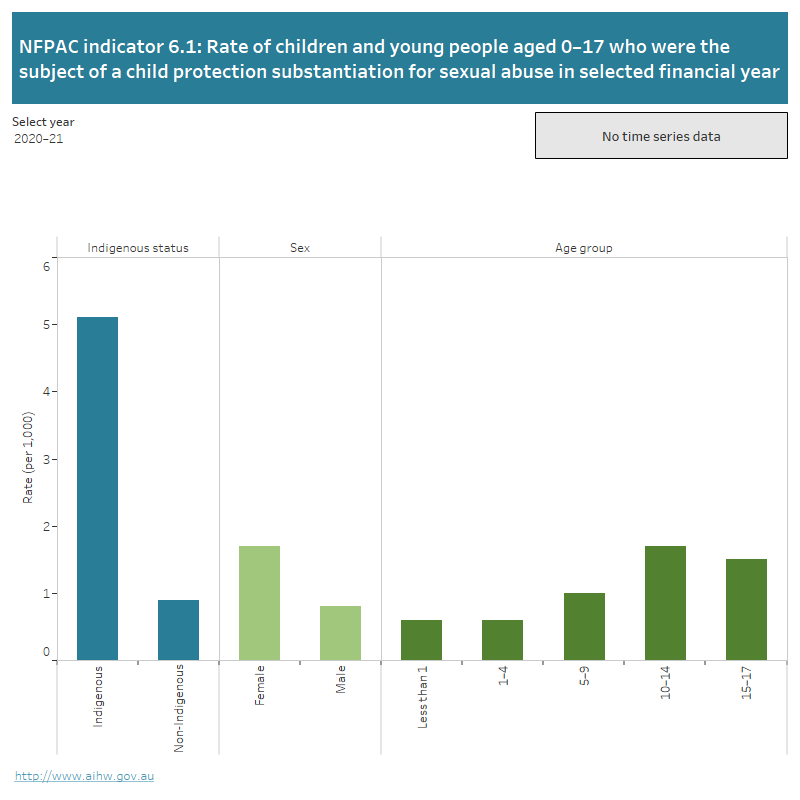6.1 Sexual abuse substantiations
Children who have been abused or neglected often have poor social, behavioural and health outcomes in childhood and later in life. In particular, a history of child abuse has been associated with difficulty in maintaining adult relationships, mental health problems including depression and anxiety, substance abuse, and violent and sexual offending later in life.
The data provided for this indicator only represent cases of sexual abuse reported to departments responsible for child protection. Instances of sexual abuse by family members other than parents/guardians and by non-family members are generally only included where there has been a finding of a failure to protect by the parent/guardian. When interpreting these data, it should be noted that, if a child was the subject of more than one type of abuse or neglect as part of the same notification, the abuse and/or neglect reported is the one considered by the child protection workers to cause the most harm to the child.
Trend data: For all indicator displays, the yearly trend is limited to indicators with 3 or more years (including the current year) of comparable time series data. To see the trend click on “Yearly Trend” button on the display. Where 3 or more years of comparable data including the most recent year is not available, a “No time series data” message is shown on the display.
The bar graph shows the rate of children and young people aged 0–17 years who were the subject of a child protection substantiation for sexual abuse by Indigenous status, sex and age group. Data can be selected by year from 2012–13 to 2020–21.

Source: AIHW Child Protection Collection
See the supplementary data tables for further information and footnotes about these data.
Indicator technical specifications
The information below provides technical specifications for the summary indicator data presented in the quick reference guide.
| Definition | Data source | |
|---|---|---|
| Numerator |
Number of children aged 0-17 years who were the subject of a child protection substantiation of a notification received in the reference period, for sexual abuse |
AIHW National Child Protection Data Collection |
| Denominator | Number of children aged 0-17 years at 31 December | AIHW National Child Protection Data Collection |
Explanatory notes
Child abuse may include neglect, physical abuse, sexual abuse and emotional abuse. Abuse is substantiated if, in the professional opinion of officers of the child protection authority, there is reasonable cause to believe that a child has been, is being, or is likely to be abused, neglected or otherwise harmed.
The administrative data reported to the AIHW on child protection substantiations reflects departmental activity. Differences in child protection legislation, policies and practices across jurisdictions and over time can affect the number and rate of children in substantiations and so caution must be used when interpreting the data.
Administrative data captures incidence of substantiations of harm, or risk of harm, rather than prevalence of abuse and neglect.
Substantiations reported for this indicator refer to investigations of notifications received during the financial year (i.e. 1 July to 30 June of the following year) for which an outcome of ‘substantiated’ was recorded within two months of the end of the financial year (i.e. by 31 August).
The primary substantiated type of abuse or neglect recorded is based on the type of abuse or neglect that child protection workers consider the most likely to place the child at risk, or be the most severe in the short term. Other types of abuse, that may be considered less serious or severe than the primary type may also be recorded as part of the substantiation.
This indicator reports on the number of children who were the subject of a substantiation of a child protection notification during the year where sexual abuse was the primary type of substantiated abuse, or an ‘other type of abuse’ recorded as part of the substantiation. Where sexual abuse is recorded as an ‘other type of abuse’ this may indicate it is considered a lower level of concern (when compared with other types of abuse/neglect) rather than an instance of serious sexual abuse. This indicator is an expansion of the previous reporting for this indicator which only reported on the primary type of abuse for the first substantiation during the year for the child.
Substantiation data generally capture maltreatment by a parent/guardian. Extra-familial maltreatment (i.e. by someone other than a child’s parent or guardian) is not within the mandate of most jurisdictions unless a child’s parents are not acting to protect the child.
The COVID-19 pandemic and the resulting Australian Government closure of the international border from 20 March 2020, caused significant disruptions to the usual Australian population trends. This report uses Australian Estimated Resident Population (ERP) estimates that reflect these disruptions.
Accordingly, in the year July 2020 to June 2021, the overall population growth was much smaller than the years prior and in particular, there was a relatively large decline in the population of Victoria. ABS reporting indicates these were primarily due to net-negative international migration (National, state and territory population, June 2021 | Australian Bureau of Statistics (abs.gov.au)).
Please be aware that this change in the usual population trends may complicate your interpretation of statistics calculated from these ERPs. For example, rates and proportions may be greater than in previous years due to decreases in the denominator (population size) of some sub-populations.


